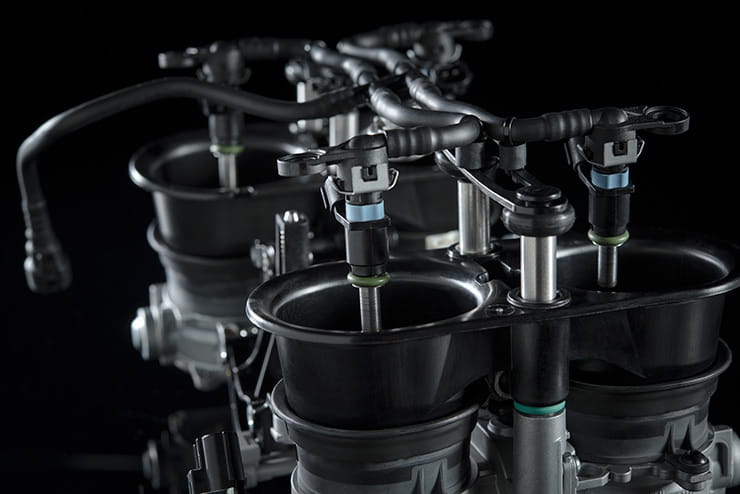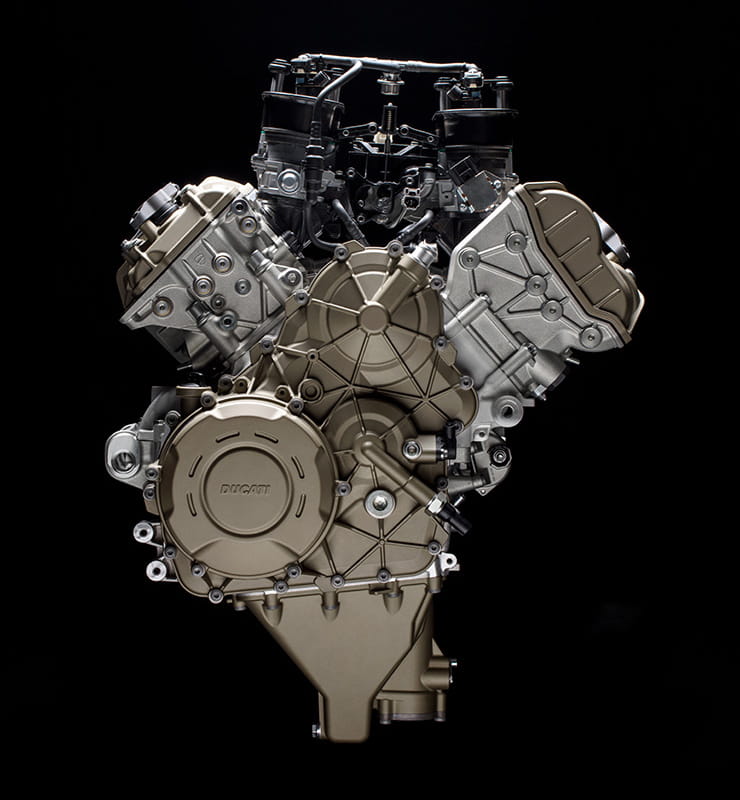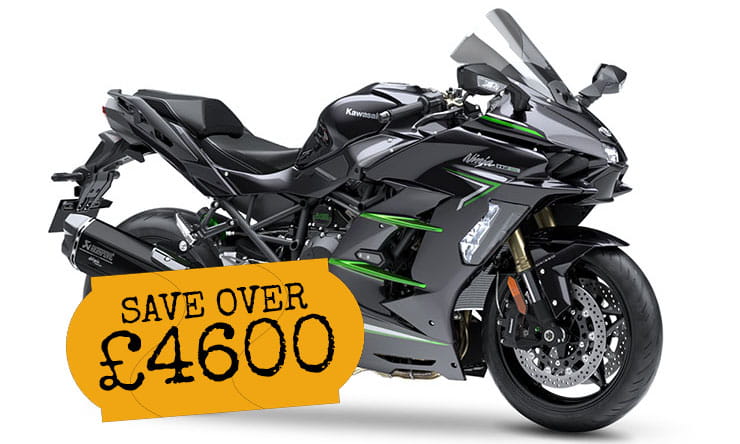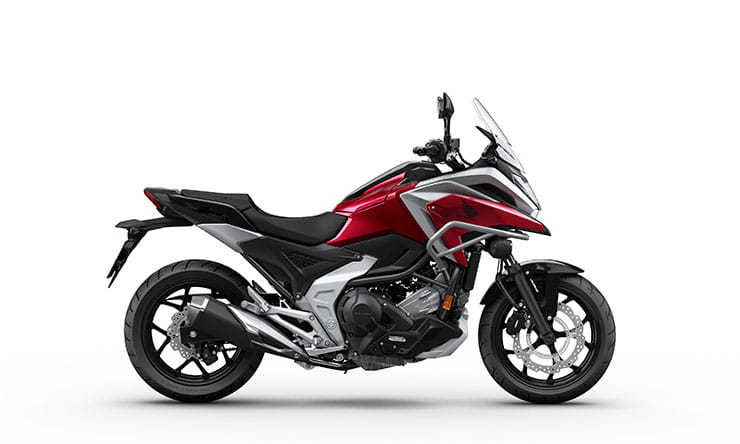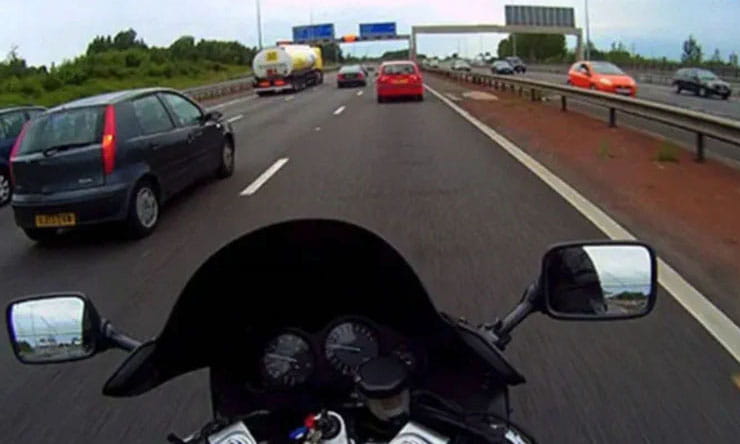While the big talking point of Ducati’s new Desmosedici Stradale-powered Panigale V4 is inevitably the firm’s shift from its traditional V-twin to a MotoGP-inspired four-cylinder engine, there’s a second factor that could well prove to be more significant still.
It’s the capacity of that V4 engine. At an unusual 1103cc it’s got a 10% advantage over the 1000cc four-cylinder superbikes that will inevitably be seen as its direct rivals. And in a market where every last iota of performance matters, 10% is a massive leg-up for the Ducati. The Panigale V4 brings a gun to a knife fight, and unless its rivals arm themselves similarly they’re going to be mown down.
Bucking the capacity classes
Bike manufacturers normally stick to an almost obsessive observance of capacity classes, and it rubs off on all of us. We think of bikes – and sports bikes in particular – as 600s, 750s or 1000s. It’s largely a result of racing regulations that impose capacity limits on entrants, which then filter through to road-going models even if they’ve got no intention of venturing on the track.
But the battle to keep increasing sports bike engine performance against a backdrop of tightening emissions limits means that there’s a growing incentive to throw those capacity limits away. Road bikes aren’t subject to capacity limits, so why hamstring your products?
Bigger engines - the technical advantage
It may be hackneyed to suggest that bigger is better, but it’s true when it comes to engine capacity.
In the simplest terms, it’s easy to see that more capacity can bring more power, but there’s more to it than that. An engine is basically an air pump. The amount of power it makes is directly related to how much air it can move. Pump more air, make more power. Simple.
There are two ways to increase the amount of air going through an engine. One is to increase revs, the other is to increase its capacity.
Revs are essentially limited by the mean piston speed, which on a road bike is realistically restricted to around 23 to 24 metres per second at peak revs. It’s calculated as stroke x 2 x revs per second. Given that the new Ducati V4 peaks at 13,000rpm (which is 216.6 revs per second), and has a stroke of 53.5mm, its mean piston speed at peak power is 23.183m/s – right on target.
A shorter-stroke engine would rev higher, potentially increasing power. For instance, Ducati’s MotoGP engine uses the same 81mm bore as the new road bike, but has a 48.5mm stroke to keep its capacity under 1000cc. The racer’s piston speed will be considerably higher; at 18,000rpm the GP17 would have a mean piston speed of 29.1m/s. But that’s simply not viable for a road bike.
Keeping the same piston speed as the 1103cc V4, but with a reduced 48.5mm stroke, a 1000cc version would make its peak power at 14,340rpm. It would be pumping the same amount of air at that speed as the 1103cc version does at 13,000rpm.
So they’d make near-identical power levels, right? Not quite. The higher revving engine will suffer more friction, so it will be thirstier, emit more and make less power. What’s more, all its components will be more highly stressed and, with revs 10% higher, will wear out faster.
Low emissions and high revs don’t play nicely
Friction may be one problem with high-revving, smaller capacity engines, but it’s not the only one. Another is emissions.
The problem is that even if you can overcome issues of piston speed and friction, there’s the simple fact that the cylinders needs to be filled with air/fuel mix and emptied of exhaust on each cycle. Revving higher means doing that faster, and it gets increasingly hard to achieve.
You’ve got to get the air into the cylinder, and at higher revs that means you need to keep the intake valves open for longer (known as increasing their ‘duration’) and wider (their ‘lift’). You also need to do the same with the exhaust valves to get all those burnt gasses out. The result is that there’s a lot of valve overlap – the period where both the intake and exhaust valves are open at the same time.
That’s bad. In emissions terms, lots of valve overlap means more unburnt fuel can escape into the exhaust, and that’s the sort of thing that Euro4 (not to mention Euro5 limits, which will come into force in 2021, during the planned life of the new Desmosedici Stradale engine) really frowns on.
Lots of valve duration and lift also makes for an engine that doesn’t work well at low revs and small throttle openings, either in terms of emissions or rideability.
Is there a downside to upsizing?
The sort of capacity increases used on the 1299 Panigale (87cc over the race-legal R version), and now on the Panigale V4 (104cc more than the expected 999cc R model) really don’t have a penalty.
In the V-twin Panigale, the increase came from a boost in bore – up from 112mm to 116mm – while the V4 uses 5mm more stroke (53.5mm compared to 48.5mm for a race-legal, 81mm bore, 1000cc four-cylinder). Neither is a change that adds to the physical size of weight of the engine, and the lower revs of the larger motors mean that there’s less friction and reduced stress on the components. That means the bigger engines can be more fuel efficient and cheaper to make than the smaller, race-oriented versions.
The emissions and economy side of the equation is particularly important. To take an extreme example, consider a fairly low-tuned 1200cc twin and a screaming 600cc four-cylinder. Both could make a peak of around 125hp. But the 1200 will pump the same amount of air at 7500rpm as the 600 will at 15,000rpm, creating far less stress and far less friction. It will use less fuel and make more low-end torque, too. That leaves size and weight as the only advantages for the smaller engine. If they’re negligible – as is the case with the Panigale, both in V-twin and V4 form – then it’s a no-brainer to use more capacity whenever possible.
What about downsized, turbocharged engines?
There’s been a lot of talk of turbo or supercharged engine for future superbikes, and as Kawasaki’s H2 proves, it is an alternative to a capacity increase.
Forced induction – compressing the intake air before it’s fed into the engine – effectively makes an engine pump more air than it would in naturally-aspirated form, so it’s fair to see boost as an equivalent to a capacity increase.
The pressurised intake air also means that valve lift and duration doesn’t need to be increased as much, and boosted engine are often tuned not to rev as high as their naturally-aspirated rivals, helping cut down on the friction issues as well.
But there’s a downside to boost. The additional components and cooling requirements make forced-induction engines harder to package, which means the whole bike, not just the engine, has to be reengineered to suit. There are also simply more parts. That means more manufacturing cost, not to mention a huge R&D investment in developing what is, in motorcycle terms, a relatively immature technology.
And with no race classes currently set up to allow turbos, outside of drag racing, manufacturers opting to boost their future superbikes won’t be able to cash in on reflected glory from track success.
So why has it taken so long for supersized superbikes to emerge?
Away from the superbike arena there’s been a gradual trend to increased engine capacity in recent years as manufacturers combat tightening emissions regulations and pander to buyers’ demands for increased performance.
We’ve seen Aprilia’s Tuono upped to 1200cc, KTM’s Super Duke R moving to 1301cc and Kawasaki’s ZZR1400 boosted from 1352cc to 1441cc. Further down the bike market, bikes that were previously 250cc are increasingly shifting to 300cc or more.
But superbikes have largely been untouched, and that’s simply because of their racing intentions.
In WSB, the rules of which also tend to be adopted by national classes, minimum production numbers for homologation were upped after the adoption of 1000cc four-cylinder bikes in 2003 and grew to 3000 by 2010. That meant it became basically impossible to use the sort of ‘homologation special’ bikes typified by the RC30 or VTR1000SP. The idea was to make production racing more closely aligned with actual mass-made bikes.
But in the last few years the homolgation requirements have been loosened, and now only 500 bikes need to be made over a two year period to enter the championship. It’s resulted in a revival of homologation specials – the Yamaha R1M, Honda CBR1000RR SP2, Kawasaki ZX-10RR and Suzuki GSX-R1000R, for example. And the logical direction will be to further separate these race models from their road-oriented equivalents.
Of course, Ducati already did it with the 1285cc 1299 Panigale – a bike that was too big to race, and required the addition of the downsized, 1198cc Panigale R to campaign in WSB. But as it was a V-twin, it was always seen as being a little different.
Now Ducati has created a four-cylinder superbike, directly rivalling the 1000cc Japanese machines buy with an extra 100cc or so in its armoury, they’ll surely be forced to react.
Who will be first to react to the Ducati?
Four-cylinder superbikes with more than 1000cc are already on the drawing board, or even approaching production.
Most notable, perhaps, is the planned 1200cc V4 that Norton is developing. Things have been a little quiet on that front since the bike was shown at the NEC last year, but Norton’s logic behind the design is sound. Not only does the increased engine size give it scope to beat rivals’ performance figures and make it easier to meet emissions limits, but vitally for Norton it also lends itself to making the engine modular. A 650cc parallel twin – basically two cylinders from the 1200, with a fractionally longer-stroke crankshaft to add the extra 50cc – is already under development, and fills a gap that a 500cc twin made from half a 1000cc engine simply couldn’t.
However, even before Norton manages it, surely Aprilia has considered the possibilities of bolting its 1177cc V4 – as used in the Tuono 1100 – into the RSV4 superbike. It’s almost a no-brainer. Both bikes share a 52.3mm stroke, but the RSV4 has a smaller 78mm bore where the Tuono has the same 81mm bore as the new Ducati. The Tuono’s engine is tuned to rev lower – peaking at 11,000rpm – but since the stroke is the same there’s little reason that a superbike version couldn’t reach the same 13,000rpm as the existing 999cc RSV4 RF. That would give it nearly identical engine dimensions as the Ducati, with just a 26cc deficit rather than a 104cc one.
Looking further ahead, there can’t be a manufacturer that hasn’t seen what Ducati has done – both with the 1299 Panigale and now with the Panigale V4 – and considered how it can react.
Fortunately, most of those with existing four-cylinder bikes should be able to add capacity, and therefore power, fairly easily. Take Suzuki’s new GSX-R1000, for instance. It has a 76mm bore and 55.1mm stroke, but the firm developed it with its existing MotoGP machine – which has an 81mm bore – as a template. Add that 81mm bore to the GSX-R1000 and it becomes an 1135cc bike. The return of the GSX-R1100? Sounds like a good idea.
Honda’s Fireblade has a similar 76mm bore as the GSX-R, and again could probably stand to have it increased. The firm has also been working on a purpose-made V4-powered homologation bike for WSB racing, using an engine derived from the RC213V-S. When that’s ready, the cheaper Fireblade will be once again excused from all racing duties – opening the possibility for the firm to play with capacity preconceptions just like it did when the original 893cc was launched into a market dominated by 750cc superbikes back in 1992.
Meanwhile, Kawasaki looks committed to taking the supercharging route with its convention-bucking future sports bikes, and who knows what Yamaha might have in store.
One thing is clear: as manufacturers distance their road-going superbikes further from their racers, we’ll benefit from more useable, more diverse machines than we’ve seen for years.



